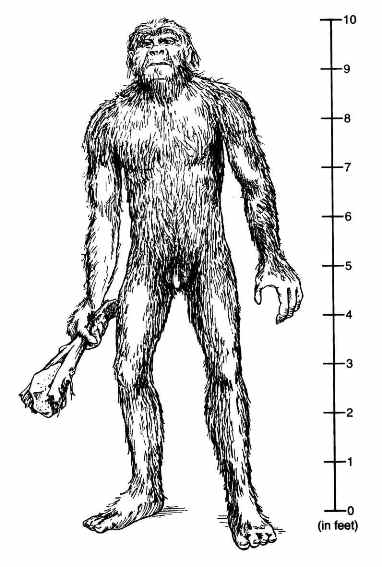
February 20, 2006
The story of the "Bigfoot" in the Endau-Rompin National Park, Malaysia, is becoming more complex. It seems like the time is ripe to sort out the media’s reports that the locals are seeing three types of hairy hominoids.
According to the Bernama news service, on February 20, 2006, accounts surfaced that the locals, the Orang Asli, living along the Johor-Pahang border, claimed they have seen a variety of different-sized "Bigfoot" in the area.

Illustration: Typical True Giant, drawing by Harry Trumbore, from Anomalist Books’ new edition of The Field Guide to Bigfoot and Other Mystery Primates by Loren Coleman and Patrick Huyghe. © 2006
Organizing what is being said, according to the three sizes, here’s what I see occurring:
1) Hantu Siaran Gigi or Hantu Hutan
Four meters (12 feet) tall, hairy man-like creatures. Hantu Hutan reportedly catch fish, and are not easily spooked by the Orang Asli. These have in the past been noted with names like "Orang Dalam." Also "Hantu Jarang Gigi" is another one that has been translated as "Snaggle-Toothed Ghost."
2) Hantu Semawa
Human-sized, probably no larger than two meters (6 feet tall). "Mawas" also has been a term for unknown, man-sized hairy hominoids seen in Malaysia. Of course, as mentioned here at Cryptomundo before, "Mawas" means, literally in nearby Indonesia, the orangutan, (Pongo pygmaeus), known from ranges in the wild in Sumatra (Pongo pygmaeus abelii) and Borneo (Pongo pygmaeus pygmaeus) but not Malaysia. Are the Hantu Semawa or Mawas seen in the Malay forest merely mainland survivor groups of orangutans?
3) Hantu Bojok
A very much smaller (one meter, three feet tall?) creature. One villager said: "Hantu Bojok is small. We’ve seen it many times. It looks like a dwarf. Once, we saw it catching fish and when it saw us, it ran away." Are these Proto-Pygmies, like the "Ebu Gogo" from Flores, Indonesia?
The Bermanu news item noted:
Tok Batin (tribal chief) Sati Pak Burut, 48, said his men had told him several times of their encounter with such creatures in the Johor forest. "My men often go into the forest for up to two or three weeks. When they return, they will tell lots of stories like seeing hantu hutan, hantu bojok and hantu semawa," he said.
Clearly, the larger creatures sound like the four-toed very tall "True Giant," the Orang Dalam from Malaysia. But then, as detailed in The Field Guide to Bigfoot and Other Mystery Primates, different types are part of what may going on too, and confusing the picture from the rainforests.
About Loren Coleman
Loren Coleman is one of the world’s leading cryptozoologists, some say “the” leading living cryptozoologist. Certainly, he is acknowledged as the current living American researcher and writer who has most popularized cryptozoology in the late 20th and early 21st centuries.
Starting his fieldwork and investigations in 1960, after traveling and trekking extensively in pursuit of cryptozoological mysteries, Coleman began writing to share his experiences in 1969. An honorary member of Ivan T. Sanderson’s Society for the Investigation of the Unexplained in the 1970s, Coleman has been bestowed with similar honorary memberships of the North Idaho College Cryptozoology Club in 1983, and in subsequent years, that of the British Columbia Scientific Cryptozoology Club, CryptoSafari International, and other international organizations. He was also a Life Member and Benefactor of the International Society of Cryptozoology (now-defunct).
Loren Coleman’s daily blog, as a member of the Cryptomundo Team, served as an ongoing avenue of communication for the ever-growing body of cryptozoo news from 2005 through 2013. He returned as an infrequent contributor beginning Halloween week of 2015.
Coleman is the founder in 2003, and current director of the International Cryptozoology Museum in Portland, Maine.
Filed under Bigfoot, Books, Breaking News, CryptoZoo News, Cryptozoology, Eyewitness Accounts, Folklore, Malaysian Bigfoot, Sasquatch, Yeti, Yowie